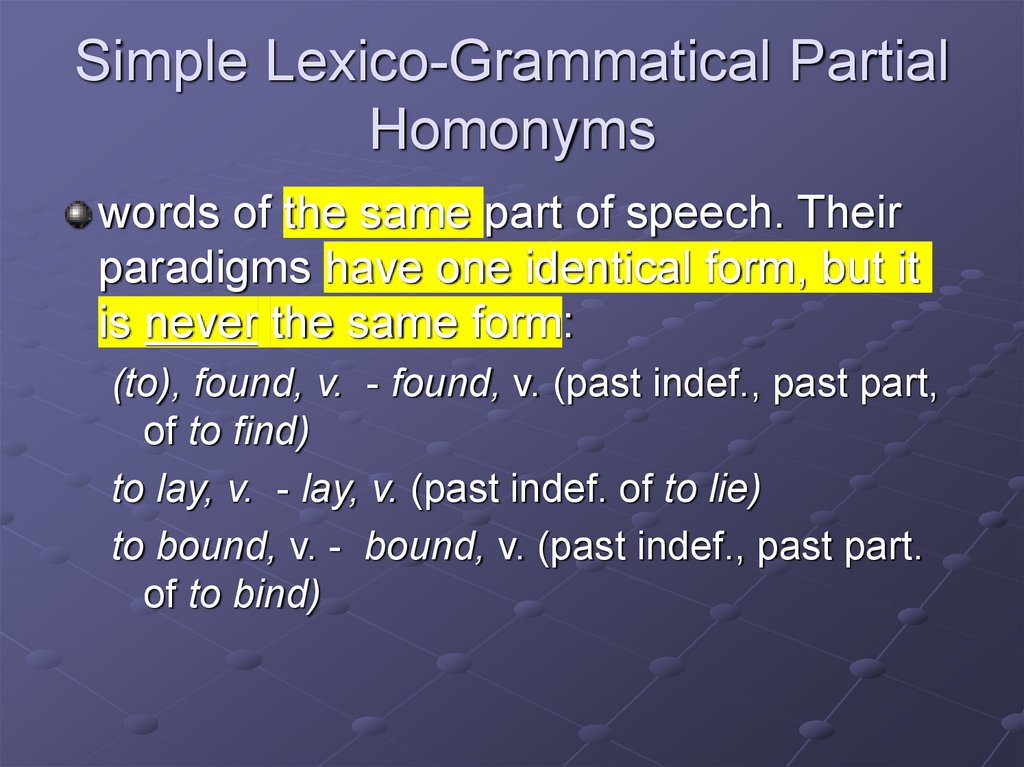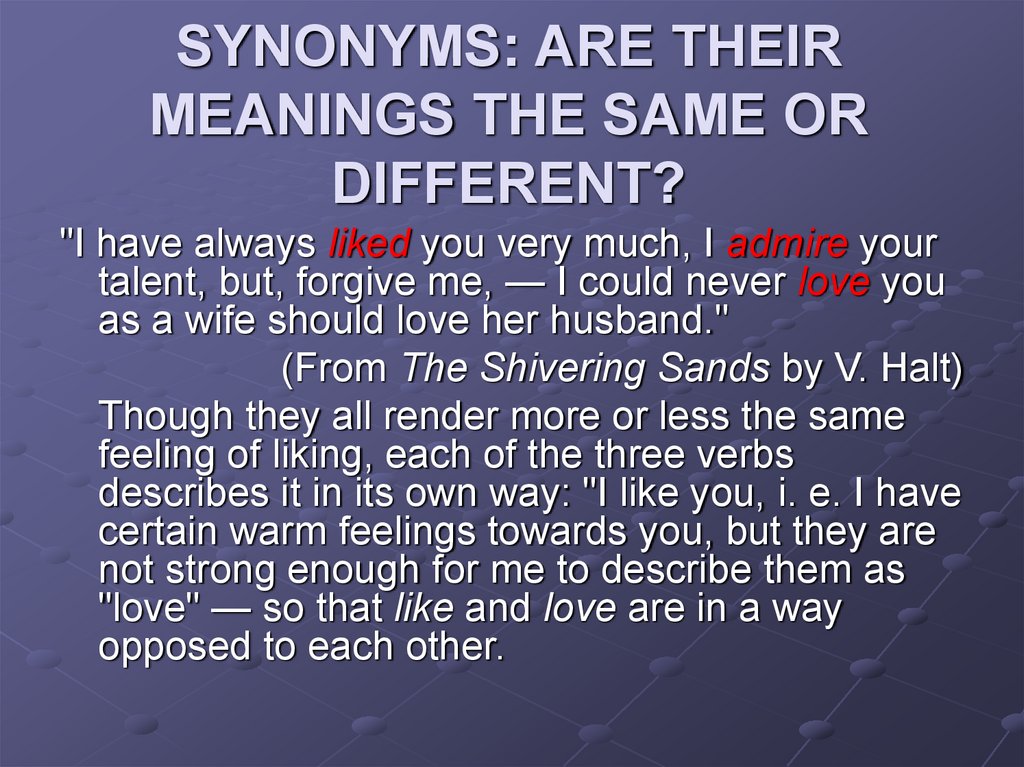Similar presentations:
Homonyms. Synonyms. Antonyms
1. HOMONYMS. SYNONYMS. ANTONYMS
Lecture 102. Homonyms
words identical in sound andspelling or, at least, in one of
these aspects, but different in
their meaning
bank, n. — a shore
bank, n. — an institution for
receiving, lending, exchanging,
and safeguarding money
ball, n.—a sphere; any spherical
body
ball, n. — a large dancing party
3. Origin and Function
homonyms are accidental and, therefore,purposeless. In the process of
communication, they are more of an
encumbrance, resulting in confusion or
misunderstanding.
Yet, they underpin popular humour (pun).
4. Pun
a joke based on the play on words of thesimilar form but different meaning (i. e. on
homonyms) as in the following
5.
6. Types of Homonyms
HomonymsHomonyms
Proper
Homophones
Homographs
7. Homonyms Proper
words identical insound and spelling
8. Homophones
Words identical in soundbut different in spelling:
night, n.—knight, n.;
piece, n. —peace, n.;
scent, n.— cent, n.—sent,
v. (past indef., past part,
of to send);
rite, n.— to write, v.—
right, adj.;
sea, n.—to see, v.—C
[si:] (the name of a letter).
9. Homographs
words identical in spellingbut different in sound:
to bow [bau], v.— to
incline the head or body
in salutation
bow [bou], n. — a flexible
strip of wood for
propelling arrows
to lead [li:d], v. — to
conduct on the way, go
before to show the way
lead [led], n. — a heavy,
rather soft metal
10. SOURCES OF HOMONYMS
phonetic changesborrowings
word-building
split polysemy
11. Phonetic Changes
in the course of their historical development, two or morewords formerly pronounced differently may develop
identical sound forms and thus become homonyms:
Night and knight were not homonyms in Old English as
the initial k in the second word was pronounced, and not
dropped as it is in its modern sound form: O. E. kniht (cf.
O. E. niht).
A more complicated change of form brought together
another pair of homonyms: to knead (O. E. cnedan) and
to need (O. E. neodian).
In Old English the verb to write had the form writan, and
the adjective right had the forms reht, riht.
12. Borrowings
A borrowed word may, in the final stage ofits phonetic adaptation, duplicate in form
either a native word or another borrowing:
in the group of homonyms rite, n. — to
write, v. — right, adj. the second and third
words are of native origin whereas rite is a
Latin borrowing (< Lat. ritus).
13. Word-Building
conversionshortening
sound-imitation (onomatopoeia)
14. Conversion
the most important type in these terms.Such pairs of words as comb, n.— to
comb, v., pale, adj.— to pale, v., to make,
v. — make, n. are numerous in the
vocabulary.
Homonyms of this type, which are the
same in sound and spelling but amount to
o different categories of parts of speech,
are lexico-grammatical homonyms.
15. Shortening
type of word-building which adds thenumber of homonyms.
fan, n. in the sense of "an enthusiastic
admirer of some kind of sport or of an actor,
singer, etc." is a shortening produced from
fanatic.
Its homonym fan, n. is a Latin borrowing
which denotes a device for waving lightly to
produce a cool current of air.
16. Onomatopoeia
forms pairs of homonyms with otherwords: e. g. bang, n. ("a loud, sudden,
explosive noise") — bang, n. ("a fringe of
hair combed over the forehead").
17. Common Features of the Sources of Homonymy
In onomatopoeia and shortening, the pairs ortriples of words homonyms have purely
incidental similarity.
Conversion, however, is an exception, for, one
word of the pair is produced from the other:
• a find < to find.)
18. Split Polysemy
Two or more homonyms can originatefrom different meanings of the same word
when, for some reason, the semantic
structure of the word breaks into several
parts.
19. Reasons of the Split Polysemy
the semantic structure of a polysemantic word isa system, within which all its constituent
meanings are held together by logical
associations
In most cases, the semantic unity of all
meanings is conditioned by one of the meanings
(e.g. the meaning "flame" in the noun fire).
If this meaning drops out from the word semantic
structure, associations between the rest of the
meanings may no longer hold, the semantic
structure loses its unity and falls into two or more
parts that then are viewed as independent
lexical units.
20. Split Synonymy (board – n.)
board, n.—a long and thin piece of timberboard, n.—daily meals, esp. as provided
for pay, e. g. room and board
board, n.—an official group of persons
who direct or supervise some activity, e. g.
a board of directors
21.
22.
Nowadays, however, the item of furniture, onwhich meals are served and round which boards
of directors meet, is no longer denoted by the
word board but by the French Norman borrowing
table, and board in this meaning, though still
registered by some dictionaries, can very well be
marked as archaic as it is no longer used in
common speech. Consequently, the semantic
structure of board was split into three units.
23. Lexico-Grammatical Typology of Homonyms
homonyms may amount to both the sameand different parts of speech.
Obviously, the classification of homonyms
is underpinned by this distinctive feature.
Also, the paradigm of each word should be
considered, since the paradigms of some
homonyms coincide completely, and that
of others only partially.
24. Types of Homonyms
HomonymsFull Lexical
Homonyms
Partial Homonyms
Partial Lexical
Homonyms
Simple
Lexico-Grammatical
Partial
Homonyms
Complex
Lexico-Grammatical
Partial
Homonyms
25. Full Lexical Homonyms
Words of the same part of speech with anidentical paradigm:
match, n. — a game, a contest;
match, n.—a short piece of wood used
for producing fire
26. Partial Lexical Homonyms
words of the same part of speech identicalonly in their corresponding forms:
to lie (lay, lain), v. to lie (lied, lied), v.
to hang (hung, hung), v. to hang
(hanged, hanged), v.
to can (canned, canned)
(I) can (could)
27. Simple Lexico-Grammatical Partial Homonyms
words of the same part of speech. Theirparadigms have one identical form, but it
is never the same form:
(to), found, v. - found, v. (past indef., past part,
of to find)
to lay, v. - lay, v. (past indef. of to lie)
to bound, v. - bound, v. (past indef., past part.
of to bind)
28. Complex Lexico-Grammatical Partial Homonyms
words of different parts of speech with oneidentical form in their paradigms.
rose, n. - rose, v. (past indef. of to rise)
maid, n. - made, v. (past indef., past part.
of to make)
left, adj. - left, v. (past indef., past part, of
to leave)
29. SYNONYMS: ARE THEIR MEANINGS THE SAME OR DIFFERENT?
"I have always liked you very much, I admire yourtalent, but, forgive me, — I could never love you
as a wife should love her husband."
(From The Shivering Sands by V. Halt)
Though they all render more or less the same
feeling of liking, each of the three verbs
describes it in its own way: "I like you, i. e. I have
certain warm feelings towards you, but they are
not strong enough for me to describe them as
"love" — so that like and love are in a way
opposed to each other.
30.
In terms of component analysis, synonyms maybe defined as words with the same denotation,
or the same denotative component, but differing
in connotations, or in connotative components.
A group of synonyms may be studied via their
dictionary definitions (definitional analysis), like
in the following:
look, stare, gaze, glare, glance, peer.
31. Semantic Typology of Synonyms
Synonymsideographic
stylistic
absolute
32. Ideographic Synonyms
ideographic (words that render the samenotion but differ in the shades of meaning):
assemble - amass, collect, convene,
summon, mobilize
table – bar, bench, board, buffet, bareau,
console, dresser, slab
33. Stylistic Synonyms
stylistic (words that differ in terms of theirusage in functional styles):
assemble – convene, gather; bunch, flock,
huddle; gang up, hang around;
good – favourable, acceptable, reputable;
delux, first-class, super; bully, bad, crack, rad,
sick.
34. Absolute Synonyms
absolute (identical in their shades of meaningand in
all their stylistic features):
articulation, pronunciation, verbalization
However, absolute synonyms are rare in
vocabulary and, at the diachronic level, the
phenomenon of absolute synonymy is
anomalous and consequently temporary: the
vocabulary system invariably tends to eliminate
it either via abolishing one of the absolute
synonyms or by developing semantic or
contextual differentiation in one or both (or all)
of them.
35. Antonyms
words of the samepart of speech with
contrasting meanings:
hot — cold,
light — dark,
happiness — sorrow,
to accept — to reject,
up — down.
36.
If synonyms form whole, often numerous, groups,antonyms are usually believed to appear in the
counterpart pairs. For instance, the adjective cold has
warm for its antonym, and sorrow may be contrasted
with gaiety.
On the other hand, a polysemantic word may have an
antonym (or several antonyms) for each of its meanings.
So, the adjective dull has the antonyms
for its meaning "deficient in interest“: interesting,
amusing, entertaining,
for its meaning "deficient in intellect“: clever, bright,
capable
for its meaning "deficient in activity“: active etc.
37. Antonyms and Parts of Speech
Most antonyms are adjectives which is natural becausequalitative features are easily compared and contrasted:
high — low, wide — narrow, strong — weak, old —
young, friendly — hostile.
Verbs take second place. Yet, verbal pairs of antonyms
are fewer in number: to lose — to find, to live — to die, to
open — to close, to weep — to laugh.
Nouns do not feature the plethora of antonyms,
however, there are some: friend— enemy, joy — grief,
good — evil, heaven — earth, love — hatred.
Antonymic adverbs split in two groups:
a) adverbs derived from adjectives: warmly — coldly, merrily—
sadly, loudly — softly;
b) adverbs proper: now — then, here — there, ever — never, up
— down, in — out





































 english
english








